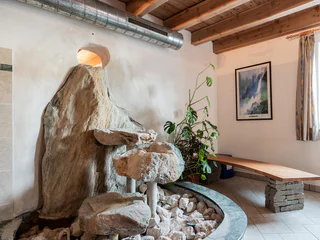
1/3
Sulphur Bath – Bad Bergfall
Valdaora di Sopra/Oberolang, Olang/Valdaora, Dolomites Region Kronplatz/Plan de Corones
Le Sud-Tyrol est remarquablement riche en contes et légendes qui se rapportent à des lieux mystérieux et à des paysages inhabituels. Des lieux mystiques comme les bancs des sorcières sur l'Alpe de Siusi racontent des histoires de sorcières et de rois, des lieux de force comme les Stoanernen Mandln avec leurs plus de cent formations de pierre ou les anciennes ruines sur la colline de Castelfeder invitent à se ressourcer. Des paysages uniques comme les pyramides de terre sont des buts de randonnées qui valent la peine.

1/3
Valdaora di Sopra/Oberolang, Olang/Valdaora, Dolomites Region Kronplatz/Plan de Corones

1/3
Velloi/Vellau, Algund/Lagundo, Meran/Merano and environs

San Nicolò/St. Nikolaus, Ulten/Ultimo, Meran/Merano and environs

1/2
Bolzano Centro/Bozen Zentrum, Bolzano/Bozen, Bolzano/Bozen and environs

1/4
Resia/Reschen, Graun im Vinschgau/Curon Venosta, Vinschgau/Val Venosta

1/3
Tires/Tiers, Tiers am Rosengarten/Tires al Catinaccio, Dolomites Region Seiser Alm

Lappago/Lappach, Mühlwald/Selva dei Molini, Ahrntal/Valle Aurina

1/3
Andriano/Andrian, Andrian/Andriano, Alto Adige Wine Road

1/3
Gomagoi/Gomagoi, Stilfs/Stelvio, Vinschgau/Val Venosta

Dobbiaco Nuova/Neutoblach, Toblach/Dobbiaco, Dolomites Region 3 Zinnen

1/2
S.Cristina Gherdëina/S.Cristina Val Gardena/S.Cristina Gherdëina/St.Christina in Gröden, S.Crestina Gherdëina/Santa Cristina Val Gardana, Dolomites Region Val Gardena

1/2
Aica/Aicha, Natz-Schabs/Naz-Sciaves, Brixen/Bressanone and environs

Aquaviva/Ackpfeif, Lana, Meran/Merano and environs

1/4
Magrè s.S.d.V./Margreid a.d.W., Margreid an der Weinstraße/Magrè sulla Strada del Vino, Alto Adige Wine Road

1/5
Glorenza/Glurns, Glurns/Glorenza, Vinschgau/Val Venosta

Egna/Neumarkt, Neumarkt/Egna, Alto Adige Wine Road

1/2
Valdaora di Sopra/Oberolang, Olang/Valdaora, Dolomites Region Kronplatz/Plan de Corones

Selva/Sëlva/Wolkenstein/Sëlva, Sëlva/Selva di Val Gardena, Dolomites Region Val Gardena

1/3
Spinga/Spinges, Mühlbach/Rio di Pusteria, Brixen/Bressanone and environs

1/3
Merano/Meran, Meran/Merano, Meran/Merano and environs

Merano/Meran, Meran/Merano, Meran/Merano and environs

Oberolang/Valdaora di Sopra, Olang/Valdaora, Dolomites Region Kronplatz/Plan de Corones

1/2
Bolzano Centro/Bozen Zentrum, Bolzano/Bozen, Bolzano/Bozen and environs

1/3
Marlengo/Marling, Marling/Marlengo, Meran/Merano and environs

1/4
S. Maddalena/St. Magdalena - Funes/Villnöss, Villnöss/Funes, Dolomites Region Villnösstal

1/3
Merano/Meran, Meran/Merano, Meran/Merano and environs

1/3
Tarres/Tarsch, Latsch/Laces, Vinschgau/Val Venosta

1/6
Naturno/Naturns, Naturns/Naturno, Meran/Merano and environs

Ora/Auer, Auer/Ora, Alto Adige Wine Road

1/4
Terlano/Terlan, Terlan/Terlano, Alto Adige Wine Road